Mobility Technology Research
Mobility is essential for health, quality of life, productivity, and independent community access. While many Canadians may take their “mobility abilities” for granted, a growing number of people must overcome mobility problems. According to Statistics Canada, disabilities related to mobility affect the greatest number of adults – approximately 2.5 million Canadians (10.5% of the population). On a global scale, over 90 million people in North America and Europe have a mobility disability. The number of people with mobility problems is increasing as our population ages.
Our research on mobility technologies covers a broad scope, from prosthetic and orthotic devices to wheelchair systems to novel technologies for assessing mobility status. This section describes various initiatives to improve mobility for people with physical disabilities.
Lower Extremity Robotic Exoskeletons
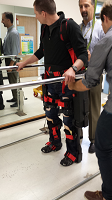 Lower extremity powered exoskeletons are intelligent assistive devices that enable people with spinal cord injuries to walk and interact with their chosen environment in an upright position. These devices are self-supporting walking frames with powered actuators at the hips, knees, and/or ankles that are controlled in realtime to create motion and resist limb collapse. A partnership between The Ottawa Hospital Research Institute (OHRI) / University of Ottawa and Bionik Laboratories Inc. has develop and tested the new ARKE exoskeleton, a novel Canadian exoskeleton from Bionik Laboratories that provides a cost effective and highly functional device for people with spinal cord injuries or lower extremity weakness. This exploratory research evaluates ARKE use within a physical rehabilitation environment to improve physical capacity for people with spinal cord injury (SCI) and then uses this information to refine ARKE so that it is ready for everyday use. Engineering research will improve joint designs and robotic control methods and create simulation models to enable innovation in this globally relevant area.
Lower extremity powered exoskeletons are intelligent assistive devices that enable people with spinal cord injuries to walk and interact with their chosen environment in an upright position. These devices are self-supporting walking frames with powered actuators at the hips, knees, and/or ankles that are controlled in realtime to create motion and resist limb collapse. A partnership between The Ottawa Hospital Research Institute (OHRI) / University of Ottawa and Bionik Laboratories Inc. has develop and tested the new ARKE exoskeleton, a novel Canadian exoskeleton from Bionik Laboratories that provides a cost effective and highly functional device for people with spinal cord injuries or lower extremity weakness. This exploratory research evaluates ARKE use within a physical rehabilitation environment to improve physical capacity for people with spinal cord injury (SCI) and then uses this information to refine ARKE so that it is ready for everyday use. Engineering research will improve joint designs and robotic control methods and create simulation models to enable innovation in this globally relevant area.
Stance Control Knee Ankle Foot Orthosis
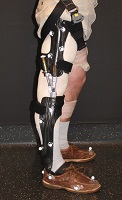 Knee-ankle-foot orthoses (KAFOs) are prescribed for people with knee-extensor muscle weakness. To help this population achieve their mobility goals, a new hydraulic knee orthosis was developed to permit a natural gait pattern. When used in a KAFO or knee orthosis, the “Ottawalk-Speed” device allows free knee motion during swing and other non-weight-bearing activities and resists knee flexion, while allowing knee extension, during weight bearing. The Ottawalk-Speed uses a novel angular-velocity control method to activate safety mode (i.e., resisting knee flexion when weight bearing). Since knee-flexion angular velocity during a knee-collapse event, such as a stumble or fall, is greater than that during walking, hydraulics can be engaged to resist knee flexion when an angular-velocity threshold is passed. The Ottawalk-Speed device does not require an external control mechanism to switch from free motion to stance control mode. Functional and bench tests have been completed to demonstrate that the orthotic system can handle large forces, provided free knee motion during walking, engaged upon knee collapse, and support body weight while the person recovers to a safe body position. Evaluation within the CAREN Virtual Reality environment showed that people with knee extensor weakness can recover from a stumble perturbation. New research has resulted in a prototype intelligent, variable resistance control of the hydraulic knee to further improve mobility.
Knee-ankle-foot orthoses (KAFOs) are prescribed for people with knee-extensor muscle weakness. To help this population achieve their mobility goals, a new hydraulic knee orthosis was developed to permit a natural gait pattern. When used in a KAFO or knee orthosis, the “Ottawalk-Speed” device allows free knee motion during swing and other non-weight-bearing activities and resists knee flexion, while allowing knee extension, during weight bearing. The Ottawalk-Speed uses a novel angular-velocity control method to activate safety mode (i.e., resisting knee flexion when weight bearing). Since knee-flexion angular velocity during a knee-collapse event, such as a stumble or fall, is greater than that during walking, hydraulics can be engaged to resist knee flexion when an angular-velocity threshold is passed. The Ottawalk-Speed device does not require an external control mechanism to switch from free motion to stance control mode. Functional and bench tests have been completed to demonstrate that the orthotic system can handle large forces, provided free knee motion during walking, engaged upon knee collapse, and support body weight while the person recovers to a safe body position. Evaluation within the CAREN Virtual Reality environment showed that people with knee extensor weakness can recover from a stumble perturbation. New research has resulted in a prototype intelligent, variable resistance control of the hydraulic knee to further improve mobility.
Smartphones for Enhancing Clinical Mobility Tests
 Novel methods, algorithms, and software have been developed for BlackBerry and Android Smartphones that use the phone’s sensors, multimedia, networking, and processing power to run the Six Minute Walk Test, Two Minute Walk Test, and 10 m Walk Test. In addition to immediate reporting of test results, biomechanical information on the person’s movements during the tests are provided immediately following the test (i.e., real-time reporting). These tools enhance information for clinical decision-making without increasing time and effort requirements.
Novel methods, algorithms, and software have been developed for BlackBerry and Android Smartphones that use the phone’s sensors, multimedia, networking, and processing power to run the Six Minute Walk Test, Two Minute Walk Test, and 10 m Walk Test. In addition to immediate reporting of test results, biomechanical information on the person’s movements during the tests are provided immediately following the test (i.e., real-time reporting). These tools enhance information for clinical decision-making without increasing time and effort requirements.
Dynamic Stability Assessment within Rehabilitation Virtual Reality Environments
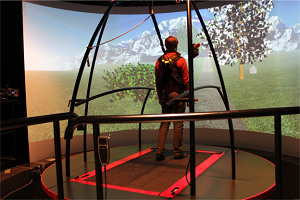 For people with mobility-related disabilities, healthcare decision-making would be improved by having a better understanding of their dynamic stability. In addition to the potential link with fall risk, dynamic stability affects movement confidence, enhanced performance, and quality of life. The CAREN-Extended virtual reality system is an ideal tool for assessing a person’s dynamic stability within environments that are more suited to moving in the community. With the appropriate measures and analysis, a better understanding of the person’s dynamic stability can be achieved, leading to better clinical decision-making. This research uses state-of-the-art virtual reality technology, realtime movement analysis, plantar pressure measurement and analysis, and assessments of movement confidence and mobility to develop dynamic stability measures that generate clinically useful information for assessing mobility. The CAREN-Extended virtual reality system incorporates a synchronized 6DoF moving platform with integrated dual-tread treadmill and dual force measurement, 3D virtual world projection on a 180º floor-to-ceiling screen, 3D audio, and realtime video motion analysis. Research is ongoing for people with lower extremity amputations.
For people with mobility-related disabilities, healthcare decision-making would be improved by having a better understanding of their dynamic stability. In addition to the potential link with fall risk, dynamic stability affects movement confidence, enhanced performance, and quality of life. The CAREN-Extended virtual reality system is an ideal tool for assessing a person’s dynamic stability within environments that are more suited to moving in the community. With the appropriate measures and analysis, a better understanding of the person’s dynamic stability can be achieved, leading to better clinical decision-making. This research uses state-of-the-art virtual reality technology, realtime movement analysis, plantar pressure measurement and analysis, and assessments of movement confidence and mobility to develop dynamic stability measures that generate clinically useful information for assessing mobility. The CAREN-Extended virtual reality system incorporates a synchronized 6DoF moving platform with integrated dual-tread treadmill and dual force measurement, 3D virtual world projection on a 180º floor-to-ceiling screen, 3D audio, and realtime video motion analysis. Research is ongoing for people with lower extremity amputations.
Amputee Gait Biomechanics with Backpack Loads
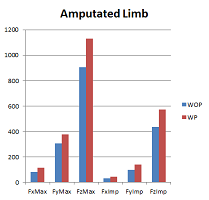 An individual’s ability to carry a weighted backpack is an important mobility consideration for many people. By understanding the changes to an individual’s gait when supporting a backpack load, the person’s ability to effectively carry heavy loads for prolonged periods could be improved. Most biomechanical studies have examined the changes in able-bodied gait when carrying a load; however, research is lacking on the effect of backpack loads on amputee gait patterns. Since military members work to return to active duty following amputation, and individuals with amputations constantly strive to lead a more active lifestyle; this is an important knowledge gap to fill. This project examined the effects of a backpack load on the gait patterns of unilateral transtibial amputees. Individuals with transtibial amputations walked on level ground, uneven ground, and ramps at a self-selected pace, with and without a backpack. Three-dimensional motion analysis data was collected to describe limb motion as well and compare kinematic and kinetic outcomes between conditions. A 24.5 kg backpack load can be accommodated by transtibial amputees at the K4 functional level. Rehabilitation programs should verify hip and knee flexor strength and work to reduce intact limb reliance. Future studies on load carriage and gait training programs should include incline and descent due to the increased dificulty.
An individual’s ability to carry a weighted backpack is an important mobility consideration for many people. By understanding the changes to an individual’s gait when supporting a backpack load, the person’s ability to effectively carry heavy loads for prolonged periods could be improved. Most biomechanical studies have examined the changes in able-bodied gait when carrying a load; however, research is lacking on the effect of backpack loads on amputee gait patterns. Since military members work to return to active duty following amputation, and individuals with amputations constantly strive to lead a more active lifestyle; this is an important knowledge gap to fill. This project examined the effects of a backpack load on the gait patterns of unilateral transtibial amputees. Individuals with transtibial amputations walked on level ground, uneven ground, and ramps at a self-selected pace, with and without a backpack. Three-dimensional motion analysis data was collected to describe limb motion as well and compare kinematic and kinetic outcomes between conditions. A 24.5 kg backpack load can be accommodated by transtibial amputees at the K4 functional level. Rehabilitation programs should verify hip and knee flexor strength and work to reduce intact limb reliance. Future studies on load carriage and gait training programs should include incline and descent due to the increased dificulty.
Effect of Snow and Ice on Exterior Ramp Navigation by Wheelchair Users
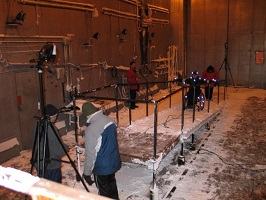 Considering the amount of time Canadians spend in winter, a remarkably small amount of literature exists on non-sporting winter activities. As a result, guidelines and standards for buildings are predominantly based on “dry-land” studies. This study provided biomechanical analysis and user feedback on ramp design and ramp negotiation strategies, which help educate wheelchair users, health professionals and builders to create a safe and accessible environment. The study was the first quantitative biomechanical analysis of wheelchair mobility on ramps under snow and ice conditions.
Considering the amount of time Canadians spend in winter, a remarkably small amount of literature exists on non-sporting winter activities. As a result, guidelines and standards for buildings are predominantly based on “dry-land” studies. This study provided biomechanical analysis and user feedback on ramp design and ramp negotiation strategies, which help educate wheelchair users, health professionals and builders to create a safe and accessible environment. The study was the first quantitative biomechanical analysis of wheelchair mobility on ramps under snow and ice conditions.
Wearable Ultrasonic Sensor
 In collaboration with Dr. Yu Ono (Carleton University) we are investigating tissue measurement applications for new thin, wearable ultrasound sensor technology. These sensors will be able to measure tissue thickness, stiffness, and muscle movement, including the effects of assistive devices on the body.
In collaboration with Dr. Yu Ono (Carleton University) we are investigating tissue measurement applications for new thin, wearable ultrasound sensor technology. These sensors will be able to measure tissue thickness, stiffness, and muscle movement, including the effects of assistive devices on the body.
